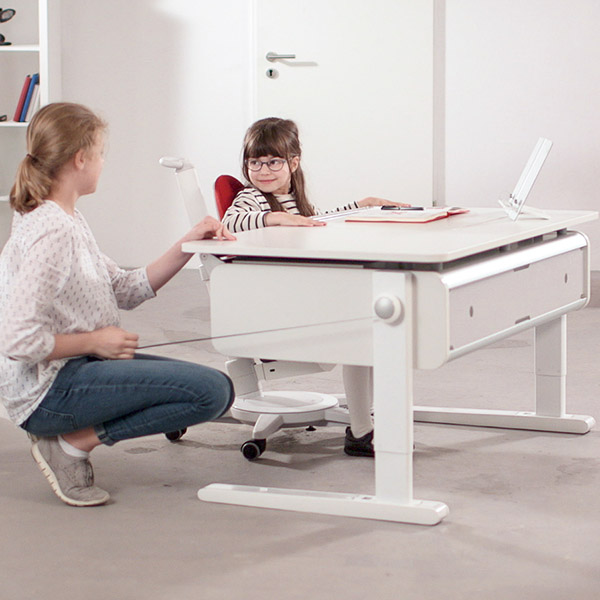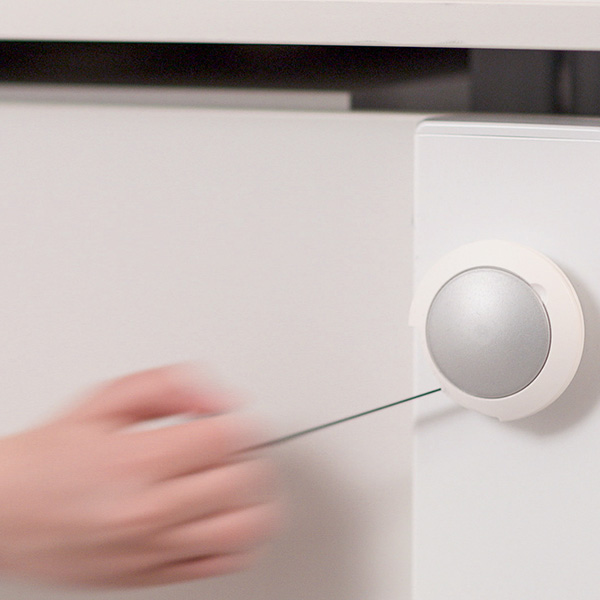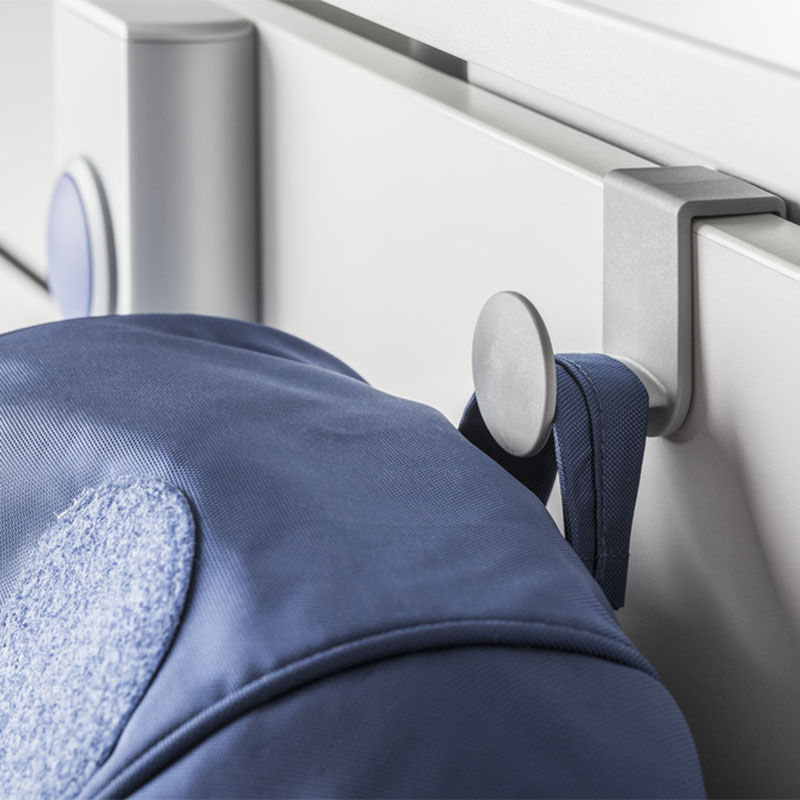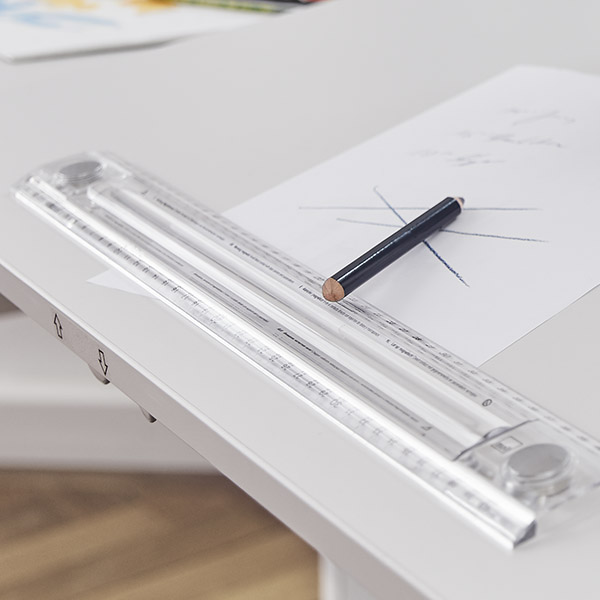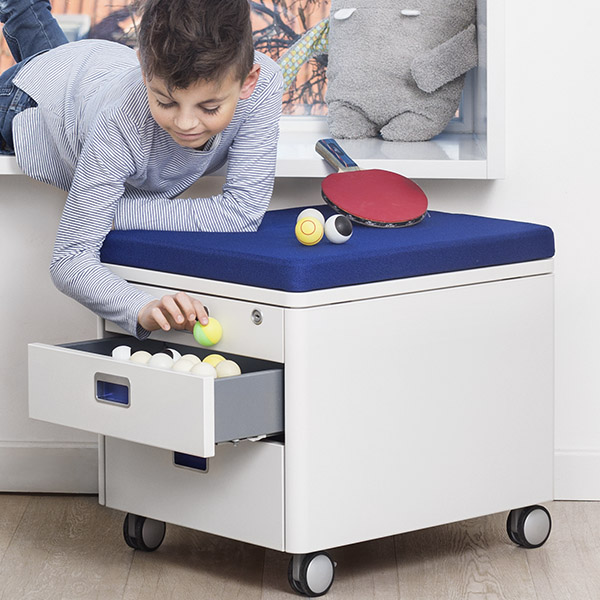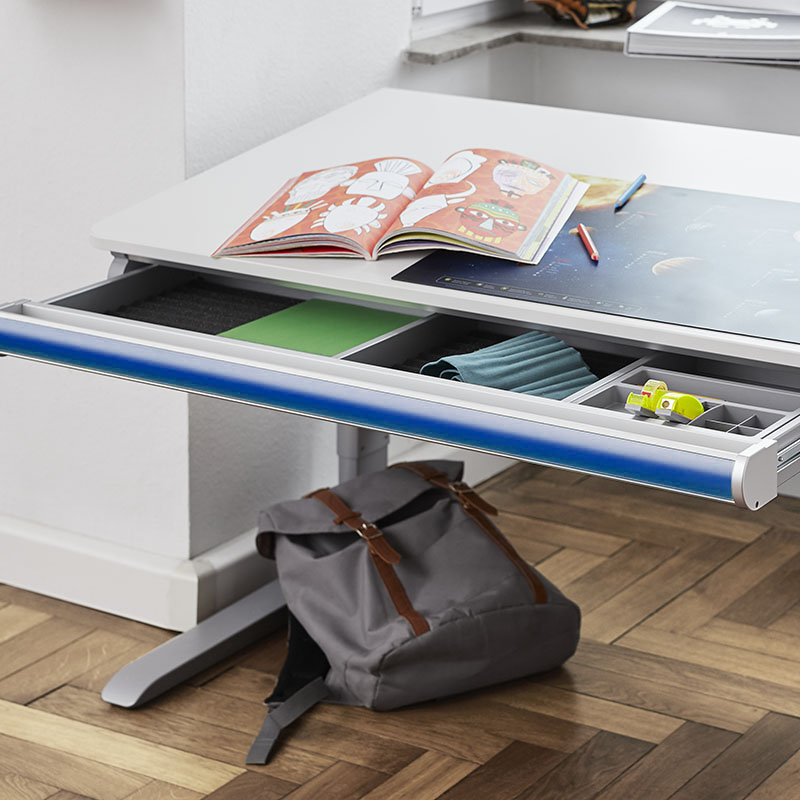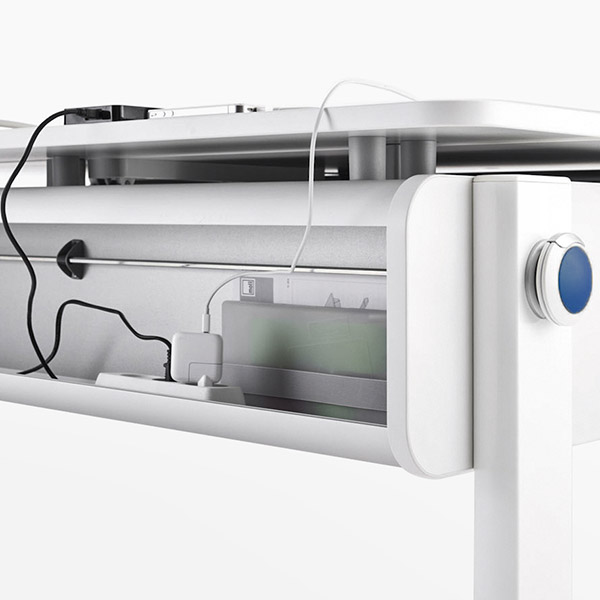What desk and chair does a first-grader need?
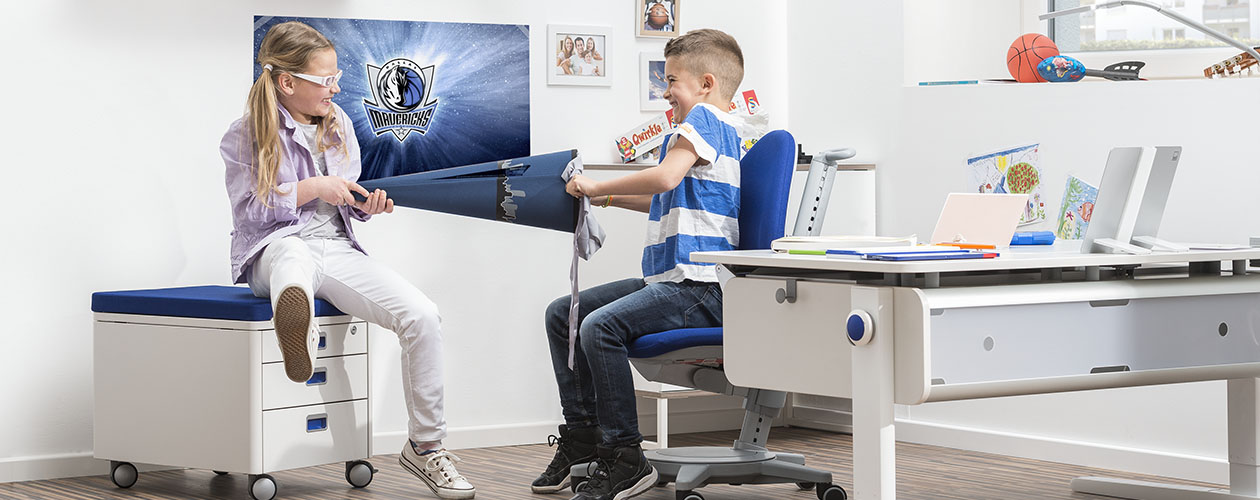
Already in preschool or kindergarten first experiences with drawing, numbers and letters are being made. A kidsdesk is therefore an optimal part of it. Children are usually incredibly proud to have their first own desk. It represents another milestone in the development to a schoolchild.
In this respect, parents should plan for the longer term and with foresight in order to spare their wallets and the environment. Even a children’s work space, which is only intended for primary school, should have a flexible kidsdesk and kidschair, since the child grows on average about seven centimetres a year.
If kidsdesk and kidsswivelchair are not suitable, there are no optimal learning conditions. The correct sitting position at children’s desks is very important, as students sometimes spend several hours a day at the desk.
Doctors and psychologists also agree that sitting still for a long time is not healthy. You are advised to change the sitting position regularly: Children should sometimes sit upright, sometimes leaning back and sometimes bent forward. This dynamic sitting promotes concentration and one works more relaxed.
Modern desks and chairs support this – rigid furniture, on the other hand, are unhealthy and lead to cramps and headaches. Today, the tilting of the table top is absolutely necessary in order to avoid tensions and later back problems.
It is also important that the table is height-adjustable so that it can be optimally adjusted to the height of the child. By the way, this also makes sense for another reason, because height-adjustable desks for children can grow with them and be used for many years to come. A good children’s desk reduces the burden on health and saves money.
However, many mistakes can be made when buying a desk. Independent testing laboratories regularly test children’s desks and pass on recommendations. Parents should inform themselves in advance and read current tests.
Which desk is the best for children?
Independent manufacturer tests that compare children’s desks include Stiftung Warentest, TÜV and Ökotest. These testing institutes examine children’s desks for their functions, flexibility, materials, toxin load and durability.
Children’s desks are made of different materials and vary in size and construction. Therefore, attention should be paid to which tables are compared in the tests. The tests are intended as a guideline and are not a substitute for advice from specialist retailers.
In general, the tests indicate that all desks should be height-adjustable for students. It should also be possible to adjust the height in as small steps as possible, as children who are growing may have to adjust the height of the desk about twice a year.
It should also be possible to tilt the table tops without increasing the risk of injury. Processing and durability play a role in the evaluation. Drawers or mobile pedestals provide space for pens and paper, pull-outs or attachments make the workstation computer-compatible.
The expandability of children’s desks is important in order to be able to grow flexibly and to enable individual work. Further extras are bag hooks, bookends or anti-slip locks, which are included with good tables. Furthermore, good stability should be ensured.
Can drawers still be closed easily and silently even after opening them 10,000 times and how much weight can a table top withstand? Does the table also have a stable base and can it be moved with wheels?
It is important to check the amount of harmful substances in the material in order to find a desk which is suitable for children. In Germany this must be specified by the manufacturer by quality seal and test method. Of course, a children’s desk should not contain harmful substances that are released into the room air, for example, formaldehyde. Parents should look out for the CE mark and the ISO specification.
One of the best-known test seals is the GS seal, which stands for “tested safety” and has been testing products in their standard and technical design since 1977.
At the last independent test by Ökotest (Jahrbuch Kleinkinder 13.01.2013), a children’s desk from the company moll won the test. The ‘Winner’ children’s desk was tested by Stiftung Warentest in 2006 and awarded the best grade of 1.7.
In essence, moll furniture meet all the criteria established by independent testing institutions such as TÜV Rheinland, Stiftung Warentest or Ökotest, such as ergonomics, adjustable table top, rounded edges, scratch-resistant table top and above all criteria such as daily use, durability, safety, absence of harmful substances and handling during assembly and dismantling.
moll desks bear the GS mark and have been awarded the Blauer Engel. Moll also offers long-term guarantees on the quality and offers the purchase of additional accessories.
Here parents find a checklist to print out, with which different desks can be easily compared with each other.
What functions does a children’s desk need?
How important is the height adjustability of desks?
A children’s desk differs from a desk or table for adults in its special adaptation to the child. This means that manufacturers should ensure that the desk grows with the child. Work surface and seat should be adjustable in different positions. If the child grows, the work surface should also be adaptable. The height of the table top plays an important role and must be right for focused work. The DIN ISO 5970 lists at which table height a healthy posture is given.
| height: | table height: | seat hight: |
| 108-121 cm | 53 cm | 31 cm |
| 119-142 cm | 59 cm | 35 cm |
| 133-159 cm | 64 cm | 38 cm |
| 146-176,5 cm | 71 cm | 43 cm |
| 159 – 188 cm | 76 cm | 46 cm |
Desks for children should be adjustable from a height of approx. 50 cm to a height of approx. 80 cm in order to be able to offer an optimal workplace for all age groups and body sizes.
The table height of moll children’s desks is adjustable from 53 to 82 cm and thus ideal for body heights of approx. 110 to 200 cm. So desks can grow with your child right up to their studies. A measuring scale on the base frame and a crank or cable pull are helpful when adjusting the table height; with both versions, the table can be infinitely adjusted by one person. The width of a children’s desk should be at least 110 cm.
What is the optimum inclination of the table top?
Every desk should have a table top with an inclined position: Why? Quite simple! When reading or writing, the head is gradually tilting towards the tabletop. This results in a “pitching posture” in which the head is strongly bent forward. This can cause unpleasant tension in the long run. But humans are not only adaptable, but above all have the ability to construct and adapt things and objects in such a way that we doe not have to adapt. This can be observed, for example, when reading. If we take a book in our hands, we hold it intuitively at an angle to avoid a crooked posture.
It is even better if the desk handles the tilting. This is why all moll children’s desks have panels that can be tilted.
Dr. Dieter Breithecker of the Bundesarbeitsgemeinschaft für Haltungs- und Bewegungsförderung e.V. says there is no such thing as the right angle for the various activities such as reading, writing or painting ‘If a table with a flexibly tiltable plate is available, you can rely on your own somatic intelligence. It describes our body perception and the feeling for doing what is good for the body – you automatically do it right.”
Children’s desks with tilted worktops improve the ergonomic sitting position and prevent incorrect sitting when reading and writing. The table surface should be optimally tiltable up to 20°. In the ideal case it is stepless as e.g. with the moll Champion.
Which extensions are important?
Not only the height of children changes, but also their comprehensible space and their needs. For school beginners it is important to have a desk on which they can see everything and find it within reach. With increasing age and more and more hobbies, additional storage space is often needed. That is why moll offers a whole range of extension elements, such as roll containers or the Flex Deck shelf.
The work surface can be enlarged by extensions (Side Top, Flex Deck or Multi Deck) or pull-outs. Drawers or simple roller containers are also a good alternative to ensure the necessary order. The respective change of the children’s desk to what the child is currently doing is necessary and makes a further difference to a normal desk. The combination of swivel chair and children’s desk is intended to be able to adjust the ideal seat and working height at any time in order to prevent postural damage.
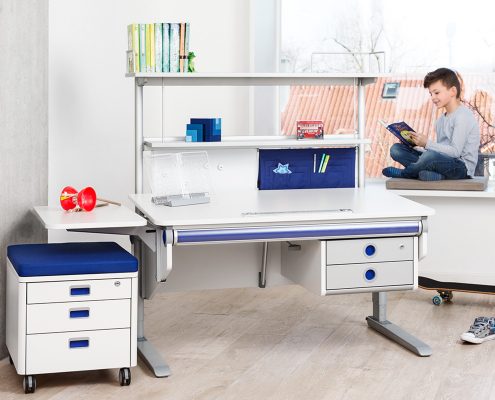
What are useful features of a children’s desk?
Bag rest or bag hook
A bag holder on the children’s desk is usually attached to the side, on which the school bag can be placed. Practically, the height of the bag holder is attached to the desk in such a way that the school bag/school backpack with the opening at the top is approximately at the edge of the table.
This makes it easier to put things into the school bag and remove. The bag hook also makes it easier to sort school supplies, especially if the bag opening is easily accessible at table edge height. With a bag rest or a bag hook, the school bag is always ready to hand, has its fixed place and can stand or hang upright without tipping over.
Book holder and anti-slip lock
Some desks have a retractable edge at the bottom of the work surface, which folds up when the work surface is tilted. Alternatively, anti-slip barriers with integrate ruler and magnifier prevent books and pens from slipping off. The models from moll also have an integrated book holders with which books or exercise books can be fixed.
Pedestals
If the desired storage space with storage compartments and drawers is not sufficient, a mobile desk container for children’s desks can be an excellent addition. The manufacturer often has the appropriate mobile pedestals to match certain desk models. These are a few extra drawers on wheels that can be pushed next to or under the desk. It is ideal if the mobile container can stand freely in the room and serve as an additional seat with a pad.
Drawers
Many desks already have one or two drawers included or have a large drawer under the table top. These are ideal as storage space for small items, pens and handicraft utensils. Even stacks of paper or unused exercise books can be put away in a structured way.
Blotting Pad
A blotting pad is suitable in many cases and can be designed according to the child’s ideas.
Cable duct
A cable duct at the back of the desk should be used to store the cable tangle. This avoids tripping hazards.
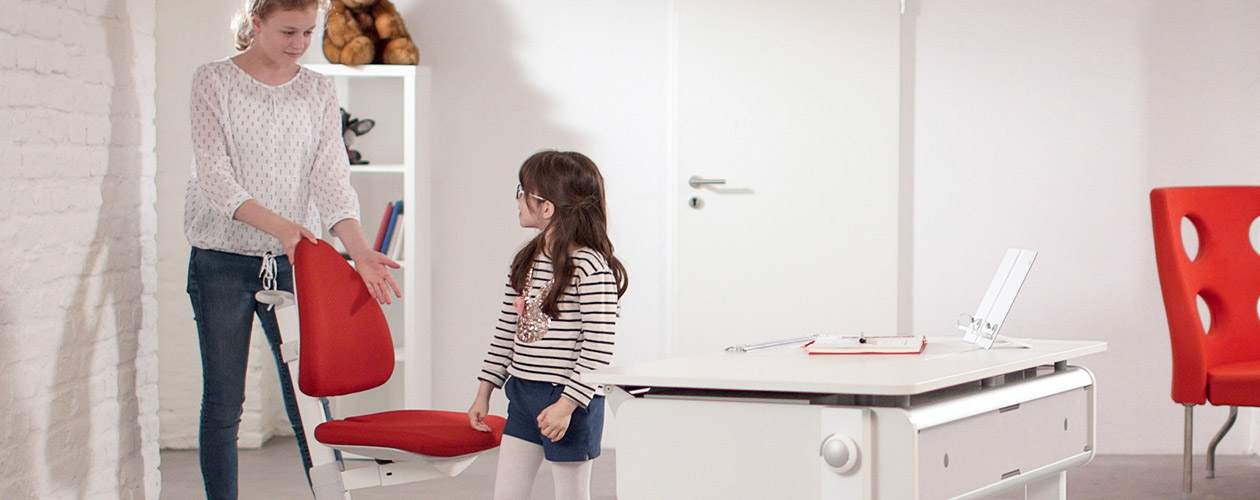
Which desk chair is the best?
For the first grader, the chair must also have the characteristics that make “dynamic sitting” possible right from the start. In contrast to ergonomic desk chairs, conventional chairs have no height adjustment, a rigidly inclined backrest and no adjustability in seat depth.
It is good for the back if both feet touch the floor. This only works if there is sufficient and easy height adjustment. The backrest is there to relieve the spine. The back should rest against the backrest below the shoulder blades.
Thus the shoulders have enough space to move and the back is well supported. This only works if the backrest is adjustable in height. In addition, you should be able to adjust the seat depth so that there is some space between the front edge of the seat and your lower legs.
Children should be supported at all times to sit not only comfortably but also ergonomically to prevent back pain. Shaped upholstery, a padded seat and a swinging backrest play an important role. They encourage and motivate people to constantly adopt a new posture and promote dynamic sitting instead of remaining in the same position.
This covers the child’s natural need for movement, the rhythmic shift of weight by e.g. rocking, tilting or swaying and the resting posture at the same time.
Öko-Test has awarded the moll Maximo 15 with the test rating ‘very good’ in 2015. Of the ten desk chairs for children and young people tested, only one other chair received the highest grade. Tested were in the categories: Handling, ergonomics, safety, materials and practical testing. The moll Maximo 15 was the only chair that achieved the test result ‘very good’ in the practical test. Öko-Test advises the purchase of quality products, as these offer school children a health-promoting workplace due to their good ergonomic properties and high-quality materials compared to cheap products.
What is the correct adjustment of chair and table?
The height adjustment is crucial for comfortable work at the table. After the purchase, the chair should therefore first be adjusted correctly.
The child’s feet should rest completely on the floor when sitting, the upper and lower legs forming a right angle and the edge of the chair should not carve into the hollows of the knees. Ideally, the sitting position should be such that the seat height corresponds to the child’s knee height. Rather, the back must be supported when sitting. If the chair is correctly adjusted, the height at the children’s desk is then adjusted.
When sitting upright, the table top is located just below the elbow after optimum height adjustment. The arms of the child should rest loosely on the table top. The upper and lower arm form a right angle.
Parents should ensure that the child does not pull his shoulders up while working. If this is the case, the chair is too low and the height of the desk too high. When working with a computer, make sure that there is a shelf for the keyboard and that the child looks directly at the monitor.
What are ideal conditions around the desk?
- enough space and legroom
- a bright room
- sufficient light or illumination
- a quiet environment
Seat at the window
It makes sense to place the children’s desk near a window. The table should be aligned in a way that the light comes from the front without dazzling the child directly.
If the children’s desk is placed to the side of the window, it is crucial which hand the child uses for writing and painting. If the child is right-handed, the light should come from the left and if the child is left-handed, the light should come from the right to avoind an annoying shadow.
Desk Lamp
To ensure that the lighting conditions are right even in bad weather and in the dark season, a suitable desk lamp must be attached to the desk to ensure adequate lighting. The ceiling lighting in the children’s room is not recommended, as unwanted shadows can interfere with writing and the incidence of light often occurs via the back.
Important with a desk lamp are the size of the light source and the mobility of the lamp. The size of the desk lamp determines how much light can shine on the work surface. The more light, the more pleasant it is to work. The mobility of the children’s desk lamp allows the light to be directed to the desired position even when changing the sitting position.
Power Outlet
When setting up the children’s desk, the cabling and the location of the sockets also play a role in addition to daylight. Not only the desk lamp needs power, but nowadays mobile phones, tablets, computers or printers are increasingly found on the desk. It is advisable to position the desk close to a power outlet and to make sure that the cables used do not become tripping hazards. The organisation of cable clutter should not be underestimated. Desks with a cable duct to accommodate all cables, chargers, etc. are ideal here.
Learn more tips on school enrolment from our guide for first graders …..
…. with tips for the time before school enrolment
Learn more tips on school enrolment from our guide for first graders …..
…. with tips for the time after the 1st day of school

